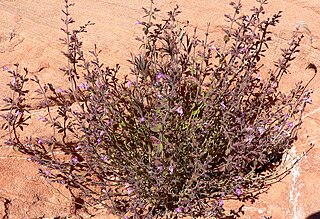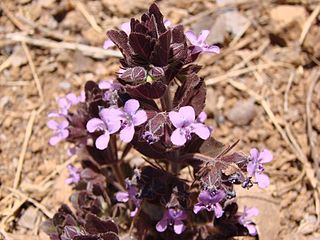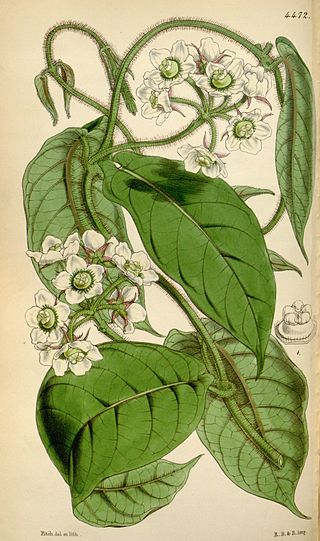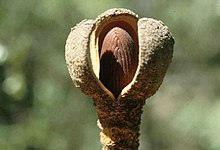
Psidium is a genus of trees and shrubs in the family Myrtaceae. It is native to warmer parts of the Western Hemisphere.

Grindelia (gumweed) is a genus of plants native to the Americas belonging to the family Asteraceae. The genus was named for Latvian botanist David Hieronymus Grindel, 1776–1836.

Ugni is a genus of plants in the myrtle family Myrtaceae, described as a genus in 1848. It is native to western Latin America from the Valdivian temperate rain forests of southern Chile and adjacent regions of southern Argentina, north to southern Mexico.

Couratari is a genus of trees in the family Lecythidaceae, first described as a genus in 1775. They are native to tropical South America and Central America.
Chamguava is a genus of the botanical family Myrtaceae, first described as a genus in 1991. It is native to southern Mexico and Central America.
- Chamguava gentlei(Lundell) Landrum - Chiapas, Belize, Guatemala, Honduras
- Chamguava musarum(Standl. & Steyerm.) Landrum - Guatemala
- Chamguava schippii(Standl.) Landrum - Guerrero, Chiapas, Belize, Guatemala, Panama

Hedeoma is a genus of flowering plants in the mint family, Lamiaceae. It is native to North and South America. They are commonly known as false pennyroyals.
Critoniadelphus is a genus of flowering plants in the family Asteraceae.

Gymnosperma is a genus of North American flowering plants in the family Asteraceae.
Trixis inula, the tropical threefold, is a plant species native to Texas, Mexico, Central America, northern South America, and the West Indies. It is found on open, sandy sites such as roadsides, thorn scrub, thickets, etc.

Celtis ehrenbergiana, called the desert hackberry or spiny hackberry, is a plant species that has long been called C. pallida by many authors, including in the "Flora of North America" database. It is native to Arizona, Florida, New Mexico and Texas, and to Latin America as far south as central Argentina. It grows in dry locations such as deserts, brushlands, canyons, mesas and grasslands.
Cissus anisophylla is a plant species known from lowland rainforests of Panamá, Colombia, Chiapas, Brazil, Perú, Costa Rica and Ecuador.

Cunila is a genus of plants in the Lamiaceae, first described in 1759. It is native to North and South America.
- Cunila angustifoliaBenth. - southern Brazil, Misiones Province of Argentina
- Cunila crenataGarcía-Peña & Tenorio - State of Durango in Mexico
- Cunila fasciculataBenth. - southern Brazil
- Cunila galioidesBenth. - Brazil
- Cunila incanaBenth. - southern Brazil, Argentina
- Cunila incisaBenth. - southern Brazil
- Cunila leucanthaKunth ex Schltdl. & Cham. - Mexico, Central America
- Cunila lythrifoliaBenth. - central + southern Mexico
- Cunila menthiformisEpling - southern Brazil
- Cunila menthoidesBenth. - Uruguay
- Cunila microcephalaBenth. - southern Brazil, Argentina, Uruguay
- Cunila origanoides(L.) Britton - central + eastern United States from Texas and Kansas east to New York and Georgia
- Cunila platyphyllaEpling - southern Brazil
- Cunila polyanthaBenth. - Mexico, Central America
- Cunila pycnanthaB.L.Rob. & Greenm. - Mexico
- Cunila ramamoorthianaM.R.Garcia-Pena - Mexico (Guerrero)
- Cunila spicataBenth. - southern Brazil, Argentina, Uruguay, Paraguay
- Cunila tenuifoliaEpling - southern Brazil

Marsypianthes is a genus of flowering plants in the family Lamiaceae, first described in 1833. It is native to South America, Central America, the West Indies, and southern Mexico.
- Marsypianthes burchelliiEpling - Brazil
- Marsypianthes chamaedrys(Vahl) Kuntze. - from southern Mexico and the West Indies south to Argentina
- Marsypianthes foliolosaBenth. - Brazil
- Marsypianthes hassleriBriq. - Paraguay, southern Brazil, Misiones Province of Argentina
- Marsypianthes montanaBenth. - Brazil

Lacmellea is a genus of flowering plants in the family Apocynaceae first described as a genus in 1857. It is native to South America and Central America.
- Lacmellea abbreviataJ.F.Morales - Colombia
- Lacmellea aculeata(Ducke) Monach - Peru, NW Brazil, the Guianas
- Lacmellea arborescens(Müll.Arg.) Markgr. - Brazil, Bolivia
- Lacmellea bahiensisJ.F.Morales - Bahia
- Lacmellea costanensisSteyerm. - N Venezuela
- Lacmellea densifoliata(Ducke) Markgr. - Pará
- Lacmellea edulisH.Karst. - Panama, Venezuela, Colombia, Ecuador, Peru, Brazil
- Lacmellea floribunda(Poepp.) Benth. & Hook.f. - Peru, NW Brazil, Suriname, French Guiana
- Lacmellea foxii(Stapf) Markgr. - Peru
- Lacmellea gracilis(Müll.Arg.) Markgr. - N Peru, NW Brazil
- Lacmellea guyanensis(Müll.Arg.) Monach - French Guiana
- Lacmellea klugiiMonach. - Peru
- Lacmellea macranthaJ.F.Morales - Ecuador
- Lacmellea microcarpa(Müll.Arg.) Markgr. - Colombia, S Venezuela, NW Brazil
- Lacmellea oblongataMarkgr. - SE Colombia, Ecuador, Peru
- Lacmellea panamensis(Woodson) Markgr. - Costa Rica, Panama, Colombia, Ecuador
- Lacmellea pauciflora(Kuhlm.) Markgr. - Brazil
- Lacmellea peruviana(Van Heurck & Müll.Arg.) Markgr. - Peru
- Lacmellea pygmaeaMonach. - Amazonas State in Venezuela
- Lacmellea ramosissima(Müll.Arg.) Markgr. - Colombia, S Venezuela, NW Brazil
- Lacmellea speciosaWoodson - Costa Rica, Panama, Colombia, Ecuador, Peru
- Lacmellea standleyi(Woodson) Monach. - Belize, Guatemala, Honduras
- Lacmellea utilis(Arn.) Markgr. - S Venezuela, Guyana
- Lacmellea zamoraeJ.F.Morales - Costa Rica

Mesechites is a genus of plants in the family Apocynaceae first described as a genus in 1860. It is native to Mexico, Central America, South America, and the West Indies.
- Mesechites acuminatus Müll.Arg. - Peru
- Mesechites angustifolius(Poir.) Miers - Hispaniola
- Mesechites citrifolius(Kunth) Woodson - Colombia
- Mesechites mansoanus(A.DC.) Woodson - Paraguay, Brazil
- Mesechites minimus(Britton & P.Wilson) Woodson - Cuba
- Mesechites repens(Jacq.) Miers - Hispaniola, Navassa Island, Jamaica
- Mesechites roseus(A.DC.) Miers - Cuba
- Mesechites trifidus(Jacq.) Müll.Arg. - widespread from Tamaulipas in NE Mexico south to Paraguay + N Argentina
- Mesechites andrieuxii(Müll.Arg.) Miers = Mandevilla convolvulacea(A.DC.) Hemsl.
- Mesechites angustatusMiers = Mandevilla benthamii(A.DC.) K.Schum.
- Mesechites brownei(A.DC.) Miers = Mandevilla torosa(Jacq.) Woodson
- Mesechites dichotomus(Kunth) Miers = Laubertia boissieriA.DC.
- Mesechites guayaquilensisMiers = Mandevilla subsagittata(Ruiz & Pav.) Woodson
- Mesechites guianensis(A.DC.) Miers = Mandevilla rugellosa(Rich.) L.Allorge
- Mesechites hastatusMiers = Mandevilla subsagittata(Ruiz & Pav.) Woodson
- Mesechites hirtellulusMiers = Mandevilla oaxacana(A.DC.) Hemsl.
- Mesechites hirtellus(Kunth) Miers = Mandevilla subsagittata(Ruiz & Pav.) Woodson
- Mesechites jasminiflorus(M.Martens & Galeotti) Miers = Mandevilla subsagittata(Ruiz & Pav.) Woodson
- Mesechites lanceolatus(R.Br.) Miers = Parsonsia lanceolataR.Br.
- Mesechites oaxacanus(A.DC.) Miers = Mandevilla oaxacana(A.DC.) Hemsl.
- Mesechites ovalis(Ruiz & Pav. ex Markgr.) Pichon = Allomarkgrafia ovalis(Ruiz & Pav. ex Markgr.) Woodson
- Mesechites plumeriiflorus(Woodson) Pichon = Allomarkgrafia plumeriifloraWoodson
- Mesechites siphiliticus(L.f.) Lemée = Tabernaemontana siphilitica(L.f.) Leeuwenb.
- Mesechites subcarnosus(Benth.) Miers = Mandevilla subcarnosa(Benth.) Woodson
- Mesechites sulphureus(Vell.) Müll.Arg. = Prestonia coalita(Vell.) Woodson
- Mesechites torulosus(L.) Miers =Mandevilla torosa(Jacq.) Woodson

Fischeria is a plant genus in the family Apocynaceae, first described as a genus in 1813. It is native to South America, Central America, southern Mexico, and the West Indies.
Tassadia is a genus of plants in the family Apocynaceae, first described as a genus in 1844. It is native primarily to South America, with one species extending north into Central America, S Mexico, and Trinidad.

Macroscepis is a genus of plants in the family Apocynaceae, first described as a genus in 1819. It is native to Latin America and the West Indies.

Cyrtocymura is a genus of Latin American and Caribbean plants in the tribe Vernonieae within the family Asteraceae.

Prunus myrtifolia, called the West Indies cherry or myrtle laurel cherry, is a New World species of shrubs in the family Rosaceae.















